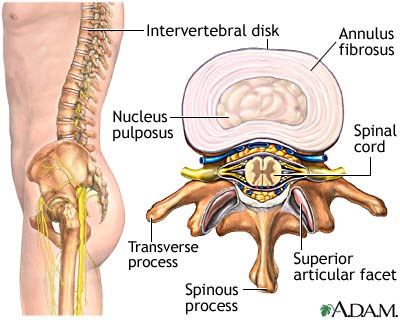Lumbosacral Discogenic Pain Syndrome
Original Editors - Sam Verhelpen
Top Contributors - Admin, Kim Jackson, Lucinda hampton, Sam Verhelpen, Oyemi Sillo and WikiSysop
Definition[edit | edit source]
Lumbar pain caused by degeneration of the intervertebral disc.
Relevant Anatomical Structures[edit | edit source]
The intervertebral disc or discus intervertebralis in latin is found between two vertebrae and consist of a semifluid nucleus pulposus with an annulus fibrosus surrounding it. The nucleus consist of 70-80% water but this decreases as people get older.[1] The annulus consist of 10-20 concentric fibrous rings, with fibers of alternating orientation. The main function of the intervertebral disc is to allow movement between two vertebrae and to transmit loads from one vertebral to the next.[1]
Etiology/Epidemiology[edit | edit source]
It should be noted that only 15% of all chronic low back pain is linked to a certain condition, the other 85% are non-specific.
According to Kallewaard JW, et al. approximately 40% of all chronic low back pain is attributed to the discus intervertebralis.[2] Although not clearly mentioned in the review, the sources that are listed, are about specific low back pain.
In the US, nearly 50% of football lineman have low back pain during a normal season. 10-27% of all college football players experience some form of lumbar spinal problems.1 Non-contact sports such as golf and cycling are also linked to low back pain.[1]
Examination[edit | edit source]
History[edit | edit source]
Discogenic low back pain typically increases when sitting, flexing the back, coughing, sneezing. In general, activities that increase intradiscal pressure.[1]
Physical Examination[edit | edit source]
There is no typical examination to determine discogenic pain. Some consider biphasic straightening from flexion an indication of problems with the discus.[2] Pain from pressure on the proc. spinosus is considerd an indication for discogenic low back pain.[2] Although these examinations give an indication, they have not been validated and additional examination is needed to determine discogenic low back pain, such as MRI and CT.[1][2][3]
Another possible test is a lumbar overpressure test. The patient sits on the table, with his back to the therapist. The therapist pushes downwards on the patient’s shoulders. If this provokes pain, the test is considered positive. The patient can also make a rounded back to provoke the anterior part of the disc, and a hollow back to provoke the posterior part of the disc.
Differential Diagnosis[edit | edit source]
Lumbosacral Disc Injuries [1]
Lumbosacral Facet Joint Syndrome [1]
Lumbosacral Radiculopathy [1]
Lumbosacral Spondylolisthesis [1]
Lumbosacral Spondylolysis [1]
Physical Therapy Management[edit | edit source]
Acute or subacute disc injuries should initially be treated conservatively. This includes physiotherapy, and the emphasis should be to reduce muscular guarding, improve segmental motion, improve mechanical faults and improve the function of the patient with a home exercise program.[1] D
Later, the patient can start with a lumbar stabilization program. [1] D
Kallewaard JW, et al. mention there being a systematic review claiming no evidence of added value of active exercise therapy in relation to bed rest and other conservative treatments such as traction manipulation, hot packs or corsets.[2] A1
Ohtori S, et al. found that patients who received surgery scored significantly lower on pain scales than patients who were treated conservatively at the two year follow up.[3] A2
Bronfort G, et al found moderate evidence that spinal manipulation (SM) is more effective than normal mobilisations (MOB) in acute low back pain. In chronic low back pain SM and MOB had a short term effect similar to NSAID’s.[4] A1
Clinical Bottom Line[edit | edit source]
With conflicting evidence for several treatment methods, it’s clear there is no one true treatment method and the therapist should see which kind of therapy the patient responds to best.
References[edit | edit source]
- ↑ 1.00 1.01 1.02 1.03 1.04 1.05 1.06 1.07 1.08 1.09 1.10 1.11 Windsor R. Lumbosacral Discogenic Pain Syndrome. 2010 http://emedicine.medscape.com/article/94673-overview#a0106 Level of evidence: D
- ↑ 2.0 2.1 2.2 2.3 2.4 Kallewaard JW, et al. 15. Discogenic low back pain. Pain Practice, Volume 10, Issue 6, 2010 560–579. Level of evidence: A1
- ↑ 3.0 3.1 Ohtori S, et al. Surgical Versus Nonsurgical Treatment of Selected Patients With Discogenic Low Back Pain. SPINE Volume 36, Number 5, pp 347–354 Level of evidence: A2
- ↑ Bronfort G, et al. Efficacy of spinal manipulation and mobilization for low back pain and neck pain: a systematic review and best evidence synthesis. The Spine Journal 4 (2004) 335–356 Level of evidence: A1







